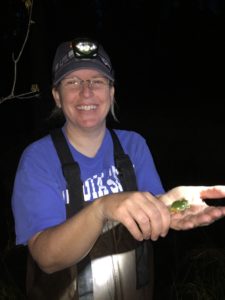By: Abby Bezrutczyk
Early detection of invasive species can be essential to their management– that’s why Dr. Julie Lockwood and colleagues are developing environmental DNA tools and studying the exotic pet trade. NYISRI is pleased to spotlight her research.

What kinds of research questions related to invasive species are you currently asking?
Our lab considers the role of the trade in exotic pets in producing invasive animals, technological advances in early detection tools, and the role of theory and frameworks for slowing the rate of biological invasions worldwide.
What are the basic methods you are using to answer your research questions?
We use a combination of data synthesis, computer simulations, and field-data collection.
Do you have a personal story or path that led to your interest in this research?
I became interested in invasive species through a fascination with birds, and doing a fair amount of data synthesis and field work on the non-native birds of Hawaii and other islands. The fact that invasive species issues interfaced with my commitment to biodiversity conservation pretty much sealed the deal for me in terms of a career-long research interest.
How does your research relate to the wider field of invasive species prevention/management?
The folks in my lab have recently pushed the use of environmental DNA toward detecting and managing invasive insects within forests and agricultural areas. We are also now exploring how to use this tool in invasive species biosecurity in the U.S. and elsewhere. Importantly, we are looking at how large data repositories, combined with decision-support tools, can help us anticipate and respond to new invaders.
What’s the most important thing about your research for managers and policy makers to know?
Given the pace of globalization, the variety of species that will appear as invasive in the US or elsewhere will only continue to expand. Therefore, it is critical that we use every available tool to anticipate these introductions, locate new populations, and respond quickly and effectively to reduce the ecological and economic impact these species can cause.
What do you hope the long-term impact of your work will be?
Fewer harmful invasive species emerging each year, and a much more robust and effective set of tools for limiting the damage such species can cause.

